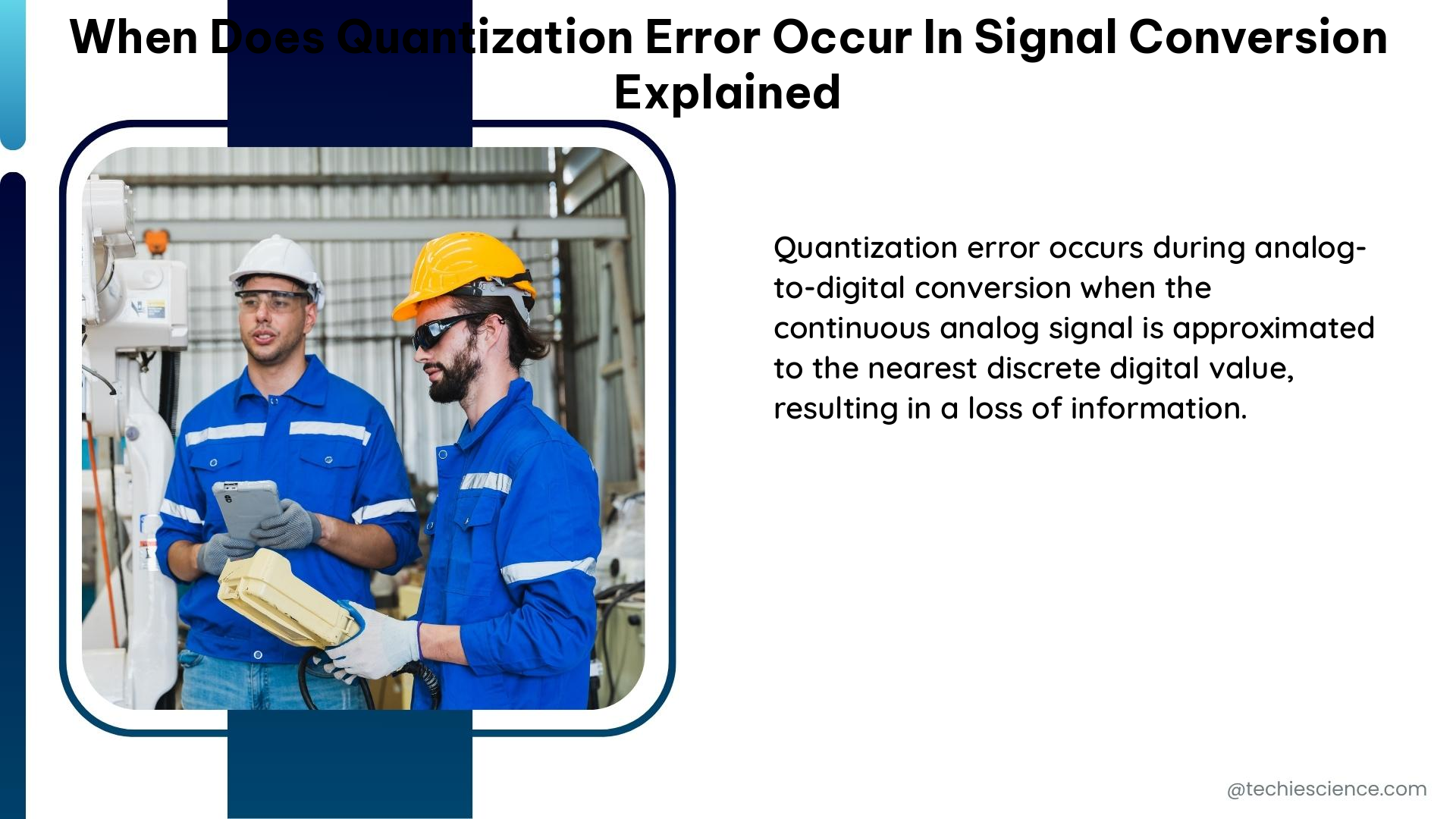Quantization error is a fundamental concept in signal processing and analog-to-digital conversion (ADC) that occurs when an analog signal is converted to a digital representation. This error arises due to the finite resolution of the ADC, which means that the continuous range of analog values must be approximated by a discrete set of digital values. Understanding the causes, characteristics, and implications of quantization error is crucial for designing and implementing effective signal processing systems.
Analog-to-Digital Conversion and Quantization
The process of analog-to-digital conversion involves sampling the continuous-time analog signal and quantizing the sampled values to the nearest digital representation. The quantization step is where the quantization error occurs.
Sampling
The first step in the ADC process is sampling the analog signal at discrete time intervals. The sampling rate, or sampling frequency, determines the number of samples taken per second and is governed by the Nyquist-Shannon sampling theorem. This theorem states that the sampling rate must be at least twice the highest frequency component present in the analog signal to avoid aliasing.
Quantization
After sampling, the continuous-time analog signal is quantized to a discrete set of digital values. The range of the analog signal is divided into a finite number of quantization levels, and each sampled value is rounded to the nearest quantization level. The difference between the original analog value and the quantized digital value is the quantization error.
Quantization Error Characteristics

The quantization error has several important characteristics that define its behavior and impact on the digital signal.
Magnitude of Quantization Error
The magnitude of the quantization error is directly related to the resolution of the ADC, which is determined by the number of bits used to represent the digital values. For an N-bit ADC, the quantization error can range from -1/2 LSB (least significant bit) to +1/2 LSB, where the LSB value is 1/2^N of the full-scale input range.
For example, a 16-bit ADC with a full-scale input range of 10 V has an LSB value of 10 V / 2^16 = 152.6 μV. The maximum quantization error for this ADC would be ±76.3 μV.
Quantization Error Distribution
The quantization error can be modeled as a uniformly distributed random signal with a mean of zero and a root-mean-square (RMS) value of Q/√12, where Q is the number of quantization levels. This uniform distribution assumption is valid when the input signal has a sufficiently large number of quantization levels and is not correlated with the sampling clock.
Signal-to-Quantization-Noise Ratio (SQNR)
The SQNR is a measure of the ratio between the signal power and the quantization noise power. For a full-scale sine wave input, the maximum SQNR for an N-bit ADC is approximately 1.761 + 6.02N dB. This means that for a 16-bit ADC, the maximum SQNR is around 96.3 dB.
Total Harmonic Distortion plus Noise (THD+N)
The quantization error can also be expressed as a percentage of the full-scale input range, known as the total harmonic distortion plus noise (THD+N). For a 16-bit ADC with a full-scale input range of 10 V, the THD+N would be approximately -96.3 dB.
Reducing Quantization Error
There are several techniques that can be used to reduce the impact of quantization error in practical applications:
-
Increasing ADC Resolution: Using an ADC with a higher number of bits (e.g., 18-bit or 24-bit) can significantly reduce the quantization error by providing a larger number of quantization levels.
-
Oversampling and Decimation: Oversampling the analog signal at a rate higher than the Nyquist rate and then decimating the digital signal can spread the quantization noise over a wider frequency range, effectively reducing the in-band noise power.
-
Dithering: Adding a small amount of random noise (dither) to the analog signal before quantization can help randomize the quantization error, reducing its impact on the final digital signal.
-
Noise Shaping: Techniques like delta-sigma modulation can shape the quantization noise spectrum, moving the majority of the noise power to higher frequencies that can be filtered out.
-
Calibration and Compensation: Applying calibration and compensation algorithms can help correct for systematic errors in the ADC, including quantization error.
Conclusion
Quantization error is an inherent consequence of the analog-to-digital conversion process, and understanding its characteristics and impact is crucial for designing effective signal processing systems. By leveraging techniques like increasing ADC resolution, oversampling and decimation, dithering, and noise shaping, engineers can mitigate the effects of quantization error and achieve high-quality digital representations of analog signals.
References
- Cadence. (2023). Quantization Errors | Advanced PCB Design Blog | Cadence. Retrieved from https://resources.pcb.cadence.com/blog/2023-quantization-errors
- Wikipedia. (n.d.). Quantization (signal processing). Retrieved from https://en.wikipedia.org/wiki/Quantization_(signal_processing)
- Monolithic Power Systems. (n.d.). Fundamental Concepts: Sampling, Quantization, and Encoding. Retrieved from https://www.monolithicpower.com/en/analog-to-digital-converters/introduction-to-adcs/fundamental-concepts
- Texas Instruments. (2011). Understanding Noise in ADC Measurements. Retrieved from https://www.ti.com/lit/an/slyt423a/slyt423a.pdf
- Analog Devices. (n.d.). Dithering in Data Converters. Retrieved from https://www.analog.com/en/analog-dialogue/articles/dithering-in-data-converters.html

The lambdageeks.com Core SME Team is a group of experienced subject matter experts from diverse scientific and technical fields including Physics, Chemistry, Technology,Electronics & Electrical Engineering, Automotive, Mechanical Engineering. Our team collaborates to create high-quality, well-researched articles on a wide range of science and technology topics for the lambdageeks.com website.
All Our Senior SME are having more than 7 Years of experience in the respective fields . They are either Working Industry Professionals or assocaited With different Universities. Refer Our Authors Page to get to know About our Core SMEs.